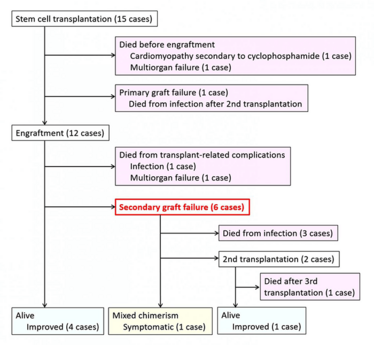Stem Cell Stepping Stones
A world-first treatment for STAT1 mutations has a disappointingly low success rate – but shows real potential
Researchers recently conducted the first study assessing hematopoietic stem cell transplant as a treatment for patients with gain-of-function (GOF) STAT1 mutations.
STAT1 plays an important role in the immune system, and GOF mutations can lead to an autoimmune response and bacterial and viral infections of varying severity. Most patients with mutations have mild or moderate symptoms, but around one in ten cases are life-threatening.
Who?
Fifteen patients between the ages of 13 months and 33 years took part in the trial. The study was carried out by an international group of researchers from countries including the US, Japan, the UK and Germany. Satoshi Okada, one of the authors of the associated paper (1), discovered the effect of GOF STAT1 mutations in 2011 (2).
How?
Treatment was given at a number of different centers across the world; a variety of donor sources and conditioning regimens prior to stem cell transplant were used.
Results?
The treatment had a success rate of 40 percent (see Figure 1); only six patients survived – five disease free, and one remaining symptomatic.
In a press release (3), Okada said, “Overall, this result is disappointing – but the fact five patients were cured proves that treatment with stem cells can work, and we now need to learn from these 15 individual cases.”

Figure 1. The prognosis of the 15 patients at completion of the stem cell treatment. Credit: Satoshi Okada.
Why?
The researchers offered three possible reasons for the low success rate. First, following transplantation, the number of healthy cells shrank with time, allowing host bone marrow to reform and resulting in transplant rejection. Second, the type of conditioning treatment used also played a role; some harsh treatments extensively damaged patient tissue. Finally, younger patients had more positive outcomes than older ones, potentially because their immune systems were less weakened by repeated infection.
What’s next?
The research team now plan to explore ways to improve the success of the treatment, including optimizing the methods used to eradicate host bone marrow, and aiming to perform transplants as early as possible.
- JW Leiding et al., “Hematopoietic stem cell transplantation in patients with gain of function STAT1 mutation”, J Allergy Clin Immunol, [Epub ahead of print], 2017. DOI: 10.1016/j.jaci.2017.03.049
- L Liu et al., “Gain-of-function human STAT1 mutations impair IL-17 immunity and underlie chronic mucocutaneous candidiasis”, J Exp Med, 208, 1635–1648 (2011). PMID: 21727188.
- EurekAlert!, “World first: Stem cell treatment for lethal STAT1 gene mutation -- shows 'disappointing' but promising results”, (2017). Available at: bit.ly/2r2wMCX. Accessed June 9, 2017.

I have an extensive academic background in the life sciences, having studied forensic biology and human medical genetics in my time at Strathclyde and Glasgow Universities. My research, data presentation and bioinformatics skills plus my ‘wet lab’ experience have been a superb grounding for my role as a deputy editor at Texere Publishing. The job allows me to utilize my hard-learned academic skills and experience in my current position within an exciting and contemporary publishing company.















